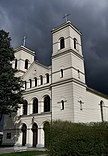Wschowa
Wschowa | ||
|---|---|---|
 Town hall | ||
|
Car plates FWS | | |
| Climate | Dfb | |
| National road | ||
| Voivodeship roads | ||
| Website | https://wschowa.pl | |
Wschowa (pronounced
History

The territory became part of the emerging Polish state under its first historic ruler
Since the mid-16th century, Wschowa was one of the centres of the
In the 18th century kings Augustus II the Strong and Augustus III of Poland often resided in Wschowa and the town was even called the "unofficial capital of Poland".[3] The Royal Castle hosted meetings of Polish kings with foreign delegations and even sessions of the Senate of the Polish–Lithuanian Commonwealth were held in Wschowa.[3] In 1737 a concordat between the Holy See and Poland was signed in Wschowa.
The Battle of Fraustadt occurred on February 3, 1706, during the Great Northern War, when Swedish forces defeated a joint army of the Polish–Lithuanian Commonwealth, Saxony and Russia. The 6th Polish Infantry Regiment was stationed in the town.[5] In the Second Partition of Poland in 1793, the town was annexed by the Kingdom of Prussia and incorporated into the province of South Prussia. After the successful Greater Poland uprising of 1806, it was regained by Poles and included within the Duchy of Warsaw, according to the Treaty of Tilsit. Jakob Walter, a Napoleonic soldier claimed to have passed through the town in 1806. He claims the town was used as a garrison and had 99 windmills.[6]

Re-annexed by Prussia and made part of the initially semi-autonomous
Fraustadt was one of the few areas within pre-war Germany
Later, Wschowa was a county (powiat) center in
Sports
Wschowa hosted the
Notable people
- Valerius Herberger (1562–1627), German Lutheran theologian
- Melchior Teschner (1584–1635), German cantor, composer and theologian
- Andreas Gryphius (1616–1664), German Baroque poet, lived at Fraustadt on and off
- starost of Wschowa, deputy to the Great Sejm, which he opened, supporter and signatory of the Constitution of 3 May 1791
- Rajmund Oppeln-Bronikowski [pl] (1787–1869), Polish officer, November Uprising participant
- Rudolf Ewald Stier (1800–1862), German Protestant theologian
- Florian Stablewski (1841–1906), archbishop, Primate of Poland
- Leo Rosenberg (1879–1963), German jurist
- Fritz Thurm (1883–1937), German resistance fighter
- Alfred Fellisch (1884–1973), German politician
- Bronisław Geremek (1932–2008), historian and politician, attended school at Wschowa
- Waldy Dzikowski (born 1959), politician, born in Wschowa
- Grzegorz Król (born 1978), footballer
- Marcin Warcholak (born 1989), footballer
- Weronika Wróblewska (born 2007), footballer
Twin towns – sister cities
See twin towns of Gmina Wschowa.
References
- ^ "Population. Size and structure and vital statistics in Poland by territorial division in 2019. As of 30th June". stat.gov.pl. Statistics Poland. 2019-10-15. Retrieved 2020-03-22.
- ^ "Atrakcje turystyczne - Oficjalna Strona Miasta i Gminy Wschowa". www.wschowa.pl. Retrieved 9 January 2018.
- ^ a b c d Łukasz Zalesiński. "Miasto królów, miasto byka". Onet Podróże (in Polish). Retrieved July 26, 2019.
- ^ Atlas historyczny Polski. Wielkopolska w drugiej połowie XVI wieku. Część I. Mapy, plany (in Polish). Warszawa: Instytut Historii Polskiej Akademii Nauk. 2017. p. 1a.
- ^ Gembarzewski, Bronisław (1925). Rodowody pułków polskich i oddziałów równorzędnych od r. 1717 do r. 1831 (in Polish). Warszawa: Towarzystwo Wiedzy Wojskowej. p. 28.
- ^ The Diary of a Napoleonic Foot Soldier by Jakob Walter
- ^ "Deutsche Verwaltungsgeschichte Schlesien, Kreis Fraustadt". treemagic.org. Retrieved 2021-01-19.
- ^ ISBN 3-447-04800-X.
- ^ FIM Sidecarcross World Championship - 2010 Calendar Archived 2011-08-12 at the Wayback Machine FIM website, accessed: 30 October 2009
External links
- Official town website
- Jewish Community in Wschowa on Virtual Shtetl









